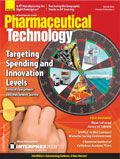No Excuse for Nonconformance
An updated book provides essential information for scientists who monitor microbial quality.
The US Pharmacopeia (USP) lists methodologies, standards, and requirements for microbiological tests used in assessing the quality of pharmaceutical and biotechnological products. These requirements are enforceable by the US Food and Drug Administration in compliance investigations. USP does not provide clear suggestions on how to perform these tests, however.
The first edition of Microbial Limit and Bioburden Tests provided a much-needed manual with practical instructions for carrying out the USP tests. Author Lucia Clontz described the compendial tests in a format familiar to practicing microbiologists.

Microbial Limit and Bioburden Tests: Validation Approaches and Global Requirements, second edition, Lucia Clontz, CRC Press, Boca Raton, FL, 2008, 280 pp., ISBN: 13-978-1-4200-5348-7.
The second edition of the book reflects the advances that have occured during the past several years, including the results of the efforts undertaken by USP, the European Pharmacopoeia, and the Japanese Pharmacopoeia to harmonize microbiological requirements and testing. The collaboration has provided industrial and regulatory microbiologists with uniform tests and reduced their workload.
Each of the chapters from the first edition has been brought up to date to conform to the new requirements, which include the modification of various testing procedures. For example, Salmonella is now tested using a different media than before. Also, the amount of sample needed for microbiological testing was changed from 10 g to 1 gm, with the exception of Salmonella testing. The harmonized text also includes a special exception for products that are only available in exceptionally small quantities and that are expensive, especially for biotechnological products.
New chapters have also been added to the book. The chapter titled "Biofilms" covers the pharmaceutical and biotechnological production equipment and materials susceptible to biofilm formation. The author provides practical advice for controlling and preventing the formation of biofilms by various means. One shortcoming, though, is the chapter's section on the qualification of chemical sanitization using biofilm cells, which would be more appropriate for a research environment than for a quality-control environment.
A chapter titled "Pharmaceutical Waters" provides a complete protocol for microbiological testing. The author deals in detail with sampling programs and sample collection and preservation. The section about recovery media is particularly well written. The chapter also discusses topics such as endotoxins testing of waters and the establishment of alert and action levels for microbiological bioburden and endotoxin levels.
Illustrations and simple diagrams are provided throughout the text to help microbiologists perform each test and procedure. In addition, separate sections provide advice about interpreting and validating each test. The procedures, interpretation of results, and validation guidelines follow the requirements in USP monographs, general chapters, and information chapters.
Several organizations market rapid methods for microbiological testing such as the identification of isolated microorganisms and the determination of microbial bioburden. Younger microbiologists often specialize in these rapid methods because they are automated and quicker than classical methods, which are labor-intensive and require days of incubation.
Clontz is well aware of the rapid methods and dedicates a comprehensive chapter to the subject. She reviews various technical platforms that have been used for rapid methods and provides photographs of the available systems. Clontz also offers a case study for genotypically similar Staphylococci and shows the application of these new technological platforms to a practical case.
The chapter has its shortcomings, however. For example, the section about validating rapid microbiological methods should have included specific examples for a given rapid test and shown how to validate these tests against the pharmacopeial tests using diagrams of procedures. The chapter also should have explained the barriers to the use of rapid methods (e.g., expense and regulatory ambivalence) and proposed solutions.
From the standpoint of microbiological control in industry, the classical methods reign supreme because of pharmacopeial requirements. It is refreshing to see that Clontz emphasizes the classical methods of microbiology. Most of the methods discussed in the book are classical methods, modified slightly because of technical advances. These methods are used by most industrial laboratories and regulatory agencies and represent current practical applications.
The second edition of Microbial Limit and Bioburden Tests clearly and comprehensively describes microbiological tests, how to validate them, and how to interpret them. The book would be an excellent tool for training microbiologists, especially in academia. Clontz leaves microbiologists no excuses for not conforming to the compendial tests, and the book should reduce the opportunity for disagreement between pharmaceutical organizations and FDA inspectors. The new edition is a must have for industrial and regulatory microbiology laboratories.
Roger Dabbah is a principal consultant at Tri-Intersect Solutions and an associate professor of technology and engineering management at the University of Maryland, University College, Graduate School, College Park, MD 20742, tel. 301.762.9258, fax 301.762.5356, rdabbah@verizon.net. He is also a member of Pharmaceutical Technology's Editorial Advisory Board.

PacBio Chosen as Tech Partner for Global Alzheimer’s Disease Research Project
April 23rd 2025The project, the North African Dementia Registry, will unite multiple entities for the purpose of developing a comprehensive dataset to advance the research community’s understanding of Alzheimer’s disease and other dementias in diverse populations.